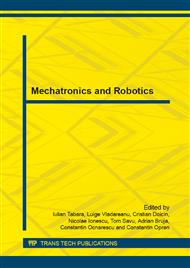[1]
Labonté F., Giraud J. -L., Polotski V. – Telerobotics Issues in the Operation of a LHD Vehicle, CAMI'95: Canadian Conference on Computer Applications in the Mineral Industry, Montréal, October 22-25, p.672 – 681, (1995).
Google Scholar
[2]
Polotski V. – Observer-Based Path-Tracking Controller for Forward/Backward Motion of an Articulated Vehicle, CAMI'95: Canadian Conference on Computer Applications in the Mineral Industry, Montréal, October 22-25, p.654 – 663, (1995).
Google Scholar
[3]
Duca C., Simionescu I. – Un principe général de formation des mécanismes, Études et Recherches de Mécanique Appliquée, ( SCMA), nr. 1, Tom 32, 1973. (en roumain).
Google Scholar
[4]
Siegwart R. , Nourbakhsh E. R. – Introduction to Autonomous Mobile Robots, MIT Press, (2004).
Google Scholar
[5]
Chavand F., Colle E. – Perception de l'environnement en robotique, Hermes, (1998).
Google Scholar
[6]
Dauchez P. – Applications non manufacturières de la robotique, Hermes, (2000).
Google Scholar
[7]
Ge S. S., Lewis F. L. (editors) – Autonomous Mobile Robots. Sensing, Control, Decision Making and Applications, CRC/Taylor & Francis (2006).
Google Scholar
[8]
Bekey G. A. – Autonomous Robots. From Biological Inspiration to Implementation and Control, The MIT Press, Cambridge, Massachusetts, (2005).
Google Scholar
[9]
Jamshidi M. (editor) – Systems of Systems Engineering. Principles and Applications, CRC Press, (2008).
Google Scholar
[10]
Labonté F., Cohen P. – Perceptual Aspects of Mining Equipment Teleoperation, in 6th Canadian Symposium on Mining Automation, October 16-18, p.179 – 188, Montréal, (1994).
Google Scholar
[11]
Pruski A. – Robotique mobile, la planification de trajectoire, Hermes, (1996).
Google Scholar
[12]
Pelecudi Chr., Simionescu I., Moise V., Ene M. – La cinétostatique des mécanismes des systèmes d'horizontalization, Symposium des mécanismes et transmissions mécaniques, Timisoara, 1980. (en roumain).
Google Scholar
[13]
Rumiantzev E. K. – Les systèmes hydrauliques des moissonneuses batteuses, Moscou Kolos, 1975 (en russe).
Google Scholar
[14]
Lacharité S., Mercier-Roy L. – Véhicule à traction hydrostatique, Projet électromécanique intermédiaire dans le cadre du programme de baccalauréat en génie électromécanique, UQAT, (2005).
Google Scholar
[15]
Brossard J. -P. – Dynamique du véhicule. Modélisation des systèmes complexes, Presses Polytechniques Universitaires Romandes, (2006).
Google Scholar
[16]
Milliken W. F., Milliken D. L. – Race Car Vehicle Dynamics, SAE, (1995).
Google Scholar
[17]
Milliken W. F., Kasprzak E. M., Metz L. D., Milliken D. L. – Race Car Vehicle Dynamics. Problems, Answers and Experiments, , SAE, (2003).
Google Scholar
[8]
Gillespie J. P. – Fundamentals of Vehicle Dynamics, SAE, (1992).
Google Scholar
[19]
Dukkipati R. V., Pang J., Qatu M. S., Sheng G., Shuguang Z. – Road Vehicle Dynamics, SAE International, (2008).
Google Scholar
[20]
Mastinu G., Gobbi M. Miano C. – Optimal Design of Complex Mechanical Systems. With Applications to Vehicle Engineering, Springer, (2006).
Google Scholar
[21]
Balandin D. V., Bolotnik N. N., Pilkey W. D. – Optimal Protection from Impact, Shock, and Vibration, Gordon and Breach Science Publishers, (2001).
DOI: 10.1201/9781482283358
Google Scholar
[22]
Bosch – Automotive Handbook, 6th Edition, SAE, (2004).
Google Scholar
[23]
Ene M. – La dynamique lagrangienne des mécanismes, Fégalma, (2013).
Google Scholar
[24]
Popov E. P. – Modern Robot Engineering, MIR Publishers, Moscow, (1982).
Google Scholar
[25]
Angeles J. – Fundamentals of Robotic Mechanical Systems. Theory, Methods, and Algorithms, Springer, (1997).
Google Scholar
[26]
Pelecudi Chr. – The theory of three-dimensional mechanisms, Editura Academiei Romane, Bucharest, 1972. (in Romanian).
Google Scholar
[26]
Ene M. Analysis en synthesis of mechanisms of manipulators with 5 degrees of mobility, Thesis, Bucharest, 1985. (in Romanian).
Google Scholar
[27]
Montana D. J. – The Kinematics of Contact and Grasp, The International Journal of Robotics Research, Vol. 7, No. 3, June (1988).
Google Scholar
[28]
Ene M. – Introduction à la théorie des mécanismes. Modèles et méthodes, Fégalma, (2013).
Google Scholar
[29]
Ene M., Moise V. – Mécanismes à membrures. Une approche structomatique d'analyse avec Matlab, Éditions Printech, (2010).
Google Scholar
[30]
Pelecudi Chr., Simionescu I., Ene M., Moise V., Candrea I., Stoenescu M., - Mécanismes à liaisons supérieures. Cames et roues, L'Institut Polytechnique Bucarest, 1982. (en roumain).
Google Scholar
[31]
Brunet C. -A., Gonzalez-Rubio R., Tétreault M. – Vers un modèle complet de pilote pour véhicules autonomes: une aproche basée sur les systèmes multi-agents hétérogènes, Troisième Conférence Internationale sur l'automatisation industrielle, Montréal, Canada, 7-9 juin (1999).
Google Scholar
[32]
Petrov P., Tétreault M., de Lafontaine J. – Path Control of a Mining Vehicle Based on a Backstepping Approach, Third International Coference on Industrial Automation, Montréal, Canada, June7-9, (1999).
Google Scholar
[33]
Tétreault M., Ehsani S. – Analyse cinématique d'un robot mobile de type automobile et stabilisation de la dynamique interne, Troisième Conférence Internationale sur l'automatisation industrielle, Montréal, Canada, 7-9 juin (1999).
Google Scholar
[34]
Petrov P., Tétreault M., de Lafontaine J. – Path Control During Backward Driving of a Tractor-Trailer with Off-Axle Hitching, International Conference on Advanced Robotics, Tokyo, Japan, 25-27 October, (1999).
Google Scholar
[35]
Petrov P., de Lafontaine J., Tétreault M. – Hybrid Feedback Control for the Parking Problem of a Load-Haul-Dump Mine Vehicle, Proceedings of the 1998 IEEE/RSJ International Confrecne of Intelligent Robots and Systems, Victoria, B. C., Canada, October (1998).
DOI: 10.1109/iros.1998.724875
Google Scholar


